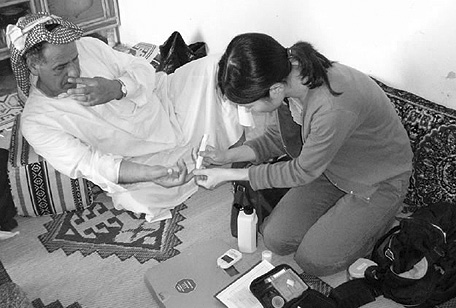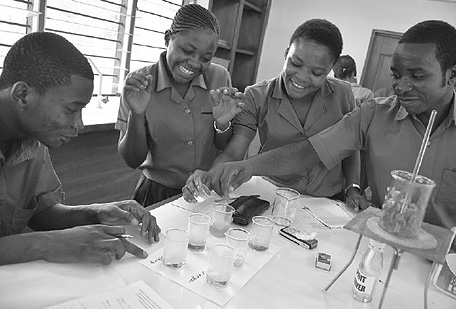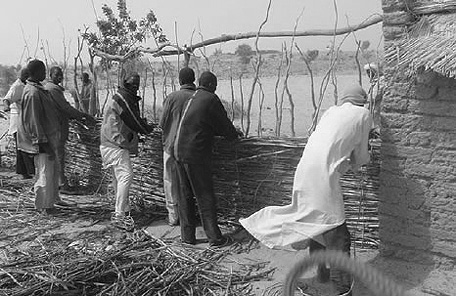Japan's Official Development Assistance White Paper 2011
Section 2 The Outlook for New Global Health and Education Policies
Japan has been working on the following issues under its new global health and education policies.
1. New Health Policy
Up to this point, Japan has attached great importance to global health as one of the global challenges that directly relate to human security. Japan has led international discussions on health system strengthening.
In recent years, Prime Minister Kan presented the "Global Health Policy 2011-2015" at the September 2010 UN Summit on the MDGs, and announced that Japan would provide $5 billion in assistance to the field of health (including an initial contribution of up to $800 million to the Global Fund to Fight AIDS, Tuberculosis and Malaria) over 5 years starting from 2011, for the purpose of contributing to achievement of health-related MDGs.
The three pillars of this new policy are (i) maternal and child health, (ii) measures against the three major infectious diseases (HIV/AIDS, tuberculosis, malaria), and (iii) response to public health emergencies, including polio and new strains of influenza. In the field of maternal and child health, which has particularly lagged behind in progress towards the MDGs, Japan aims at providing assistance based on the EMBRACE model.* (Note 3)
Under this new policy, Japan has been working with other stakeholders including international organizations in a mutually complementary manner in Ghana, Bangladesh, and other countries, to provide support to enable partner countries tackle issues and achieve the health-related MDGs. In particular, in addition to the aforementioned financial contributions to the Global Fund, Japan steps up complementarity between the Global Fund's activities and Japan's bilateral assistance, with the aim of furthering progress in MDG6 concerning the three major infectious diseases.
In addition, Japan has made its first contributions to the GAVI Alliance* (Note 4) in an effort to achieve the maximum results through increased access to immunization in poor countries. Japan has also been working closely with the Bill and Melinda Gates Foundation and other stakeholders towards global polio eradication through providing loan as well as grant assistance to support immunization campaigns against polio. (See page 60 for Health and page 80 for Infectious Diseases.)

In Syria, a health worker of Japan Overseas Cooperation Volunteer measures a villager's blood glucose level and conducts health management (Photo: Katsuaki Takahashi)
Terminology
*EMBRACE model
Assistance for pregnant women to ensure seamless treatment, both prenatal and postnatal. Regular checkups for pregnant women, treatment for newborns at hospitals that have the appropriate equipment and personnel, improvement of access to hospitals, and vaccinations, etc., are provided in cooperation with the international community.
*GAVI Alliance (Global Alliance for Vaccines and Immunization)
An innovative partnership amongst major players in global immunization that aims at saving children's lives and protecting people's health by increasing access to immunization in poor countries. The alliance includes the key UN agencies, vaccine industry, bilateral aid agencies and major foundations.
Notes:
(3) EMBRACE model: Ensure Mothers and Babies Regular Access to Care (EMBRACE) model
(4) GAVI Alliance: The Global Alliance for Vaccines and Immunization (GAVI)
2. New Education Policy

At a teacher training school, Ghanaian students work on a science experiment led by science and mathematics teachers of Japan Overseas Cooperation Volunteers (Photo: Teppei Aoki)
Education is a human right. Japan has emphasized cooperation in the education sector as an essential part for promoting human security. Following the Basic Education for Growth Initiative (BEGIN) that was announced in 2002, Prime Minister Kan presented the "Japan's Education Cooperation Policy 2011-2015" at the September 2010 UN Summit on the MDGs, and announced that Japan would provide $3.5 billion of aid over a period of 5 years beginning in 2011, for the purpose of contributing to achievement of the MDGs and Education for All (EFA)*.
The three pillars of this new policy are (i) aid for basic education, (ii) aid for post-basic education (secondary education following the completion of primary education, vocational training and education and higher education), and (iii) education aid for vulnerable countries that have been affected by conflict or disasters. To implement "School for All," a basic education aid model that is designed for comprehensive improvement of the learning environment by schools, communities, and educational administration, Japan provides support for (i) quality education (teacher training in science and mathematics in Africa, etc.), (ii) provision of a safe learning environment (improvement of nutrition and hygiene, etc.), (iii) school based management (School management improvement through community participation projects in Niger, etc.), (iv) openness to the community (adult literacy education, etc.), and (v) inclusive education (assistance for children with difficulty to attend school due to extreme poverty, disabilities, etc.), and also enhances support for the EFA Fast-track Initiative (EFA-FTI) international framework for the spread of primary education.
In efforts related to post-basic education, Japan encourages the strengthening of vocational training schools, building of a higher education network (higher-education projects in the Asia and Africa regions, such as AUN/SEED-Net and E-JUST) (Note 5), and receiving and exchange of international students, and cooperates with international organizations to provide assistance in vulnerable countries (construction of schools in Afghanistan through UNICEF, etc.). (See page 57 for details regarding Education.)

The "Support to the Improvement of School Management through Community Participation (School for All) Project" Members of the community in Niger repair a school on their own (Photo: Hiroyuki Uemura)
Terminology
*Education for All (EFA)
Education for All (EFA) is an international movement that aims to ensure that everyone in the world has the opportunity to receive at least a basic education. The five main organizations involved with EFA are the United Nations Educational, Scientific and Cultural Organization (UNESCO), the World Bank, the United Nations Development Programme (UNDP), the United Nations Children's Fund (UNICEF), and the United Nations Population Fund (UNFPA), with UNESCO serving as the overall coordinator. EFA encompasses a number of initiatives, such as the Education for All – Fast Track Initiative (EFA-FTI).
*EFA Fast-track Initiative
A framework for international aid established under the leadership of the World Bank in 2002, in order to achieve the universal primary education by 2015 that is included in the MDGs and the EFA Dakar Framework for Action. In November, 2011, the name of FTI was changed to “Global Partnership for Education.”
Notes:
(5) AUN/SEED-Net: ASEAN University Network/Southeast Asia Engineering Education Development Network
E-Just: Egypt-Japan University of Science and Technology
